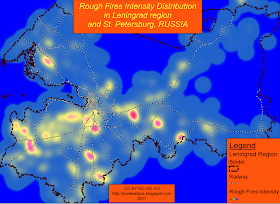Instead of introduction
Just for fun I decided to investigate relationship between fires intensity in Leningrad region (and St. Petersburg as well) and distance to the nearest road in order to gain the evidence of the major influence of the anthropogenic factor on fire starting.
Materials and methods
Data used:
- FIRMS fire data;
- OSM data from GIS-LAB.info.
OSM data about major roads of Leningrad region was used to create a distance map. Distance map and data about locations of the fires detected from 2001 to June 2011 were used as arguments for the R "rhohat" function of "spatstat" package in order to investigate dependence of fires intensity on distance to the nearest highway.
Results and discussion
Firstly lets look at the map of the fires intensity distribution in space below (this map is rough and was created just to demonstrate the situation in general and it wasn't used for the computations described below). Due to usage of the roads at this map will be a hinder for fire data I used railways instead.
 |
| Rough fires intensity distribution in Leningrad region |
As you can see, fires intensity is [somewhat] related to the location of the railways: note that there are almost no fires at the east side of the map where railways net is sparse (north side of the map is similar, but there is Ladoga Lake located). Ofcourse railways are not the cause for the fires by themselves, but I suppose that in this particular case this can be evidence of the significant human influence on the fire events.
I believe you think that if we want to find clear evidence of the human influence on starting fire than we should investigate density of the population and compare it to the fires intensity. Fair enough, but you may do it by yourself using official data if you want. I will not do it because the results will be flawed. There is an issue with population - there is no data for the actual population of Leningrad region in summer (late spring and early autumn as well) time - the time of fires. At this time a lot of people from St.Petersburg go to their summer houses in Leningrad region (take into account that the population of St. Petersburg is 5 times higher than a population of Leningrad region) and you have to estimate population of the region accordingly, and it is far not a trivial task.
So we have to investigate not the population density by itself, but the proximity of the areas that were on fire to the population. We will measure the proximity as a distance to the nearest highway. Ofcourse it is better to use all available roads for such research, but if we will do so, R will calculate it for a very long time (there are over 80 000 features in the shp-file) - I've stopped the process after 10 hours of waiting. So I've used only major highways (with "primary", "secondary", "trunk", "tertiary" and "motorway" attributes in OSM) - over 10 000 features.
rhohat{spatstat} function was used to create the following graph:
 |
| Dependence of the fires distribution on the distance to the nearest highway |
There is an interesting "sinusoid" from 18th to 38th kilometre. Narrow gray stripe demonstrates possible error so I assume that this graph is reliable. I need to explain it somehow. My wife who is better mathematician than I tells that the best explanation is a shitty computation. Well, it is possible. But I have another opinion.
Possible explanations:
- Remember that we left more than 70 000 roads outside our calculations for this graph and there are a lot of roads which are not recorded in OSM. I suppose that if we would use almost complete dataset of roads in Leningrad region and more powerful computer than mine we would have more adequate graph where this sinusoid may disappear.
- Proximity, estimated here is not only a proximity for "occasional fire starters" but also a proximity for fire fighters. If a fire starts far away from the road it is more difficult to fight it. So this is about fire data and how we treat it for the computation: it is possible that fire events are continuously less frequent as we move away from the highway, but single event produce fire which covers larger area than average due to it is hard to fight it quickly, and this single event produce more "hotspots" (which were used for this mini-research) than average event.
Conclusions
We have got a strong evidence that anthropogenic factor plays a major role as cause for fire in Leningrad region: intensity of fires riches its maximum at distance of 2-3 km away from the road and then goes down.
"Sinusoid" between 18th and 38th kilometres may be caused by insufficiency of the road data used. Calculations should be repeated with more comprehensive data. Also it may be necessary to pre-process fire data in order to replace "hotspots" related to a single fire event with the single point i.e. to make it one point for one fire.
UPD: the story continues here.
Awesome post, thanks. Really enjoyed it. Which r function did you use to implement the "nearest distance to X" function (or was it created outside of r?) ? Thanks!
ReplyDeleteThank you Paul! You might be interested in this post as well.
DeleteThe function I used was 'rhohat()' from the 'spatstat' package. If you use QGIS it is implemented as 'Relative distribution...' scripts in 'Processing toolbox' under 'R scripts' -> 'Point Pattern Analysis' -> 'Relative distribution...'.